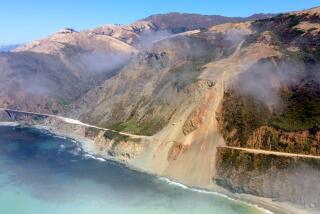Walking away from a highway
In a standoff with federal forest officials, Caltrans is proposing to abandon a popular, cliff-hanging highway in the San Gabriel Mountains because it is too expensive to maintain.
The proposal to walk away from California Highway 39, enjoyed by an estimated 3 million people a year, comes as the state struggles to close a $9.2-billion budget shortfall.
To avoid closure, the California Department of Transportation is trying to persuade the U.S. Forest Service or Los Angeles County to take over the roadway, which runs 27 miles from the city of Azusa nearly to the crest of the San Gabriels. Neither agency wants it.
“So far, they have gracefully declined to take on this responsibility, and Caltrans is stuck with the costs,” said Ronald J. Kosinski, Caltrans’ deputy district director for environmental planning. “I hope people don’t start digging in their heels over this matter.”
L.A. County needs the highway to access three dams critical to flood control. But Tony Bell, spokesman for county Supervisor Michael D. Antonovich, whose district includes the San Gabriels, said the county has no desire to assume responsibility. “Why would it?” he asked.
The Forest Service’s interest is access to the Angeles National Forest by the public and, at times, by firefighters. The agency spent $6 million improving a spacious campground at Crystal Lake, where the highway now ends after winding along the San Gabriel River past the Morris and San Gabriel reservoirs.
“We met with Caltrans and told them we do not have the resources or funds to maintain that state highway,” said Forest Service engineer Sonja Bergeahl.
The issue led to a bout of brinkmanship in recent days.
Kosinski told The Times that Caltrans is operating the road under a special permit dating to the 1920s, when the highway was built. “According to the agreement, the only way we can extricate ourselves from it is to abandon the highway,” he said.
The Forest Service says it has a different interpretation, one that would cost Caltrans dearly. “The permit does say that if Caltrans abandons the highway, they have to remove their improvements -- meaning the road -- and return the area to the natural landscape,” Bergeahl said.
Caltrans spends $1.5 million a year maintaining the two-lane paved roadway, which is damaged regularly by landslides, flooding, falling rocks and forest fires. The agency said that abandonment is a rare step, possibly unprecedented. Caltrans could not immediately cite another instance in which it walked away from a state route.
Abandoning the highway to save $1.5 million a year is not significant for an agency that spends $13 billion a year to manage 50,000 miles of road statewide. But Caltrans said the proposal is consistent with its efforts to cut costs wherever it can -- and Highway 39 presents a unique situation.
A landslide swept away the highest part of the road in 1978, cutting it off from Angeles Crest Highway. Since then, that last stretch of asphalt has been roamed by Nelson’s bighorn sheep, creatures fully protected under state law. Caltrans concluded that it would be cost-prohibitive to re-engineer that 4.4-mile gap and legally risky to try because it cannot guarantee that the sheep would not be killed in the process.
As a result, the highway has become what Caltrans spokesman Patrick Chandler described as “essentially a 27-mile-long cul-de-sac.”
Kosinski said he was waiting for more guidance from agency attorneys. Caltrans might be able to sweeten the offer to the county or Forest Service by providing money to cover several years of maintenance, he said. “Putting up a gate at the southern end of the highway and simply handing over the keys to the Forest Service is another option.”
About 500 people rely on the highway to reach their homes, said Barret Wetherby, former president of the San Gabriel Canyon Homeowners Assn. Wetherby said he does not believe the road will ever be abandoned.
“I think Caltrans is bluffing, and it’s not going to work,” he said. “It’s the gateway to the San Gabriel Mountains, and we need it open every day and night so that flatlanders can recreate up there, and folks can evacuate in the event of an emergency.”
Adam Samrah, 54, bought the Crystal Lake Snack Bar Trading Post in 2002, shortly before the area was closed for nine years because of damage from a forest fire. He finally opened for business in March after spending about $107,000 in renovations.
Closing Highway 39, the only road that accesses the store, “would destroy me,” Samrah said. “I’m sick over this. It doesn’t make sense.”
Caltrans spokesman Chandler visited the rustic cafe this week and tried to reassure Samrah. “All we want to do is abandon the highway,” Chandler said. But that doesn’t necessarily mean the highway will be closed, he said.
Samrah, a Turkish immigrant who speaks broken English, had trouble understanding the difference.
“What if nobody else wants the highway?” Samrah asked. “What if you shut it down? I’m not a rich guy. I can’t afford to sue a giant like Caltrans.”
“We’ll be in touch,” Chandler said before heading down the mountain.
More to Read
Sign up for Essential California
The most important California stories and recommendations in your inbox every morning.
You may occasionally receive promotional content from the Los Angeles Times.











